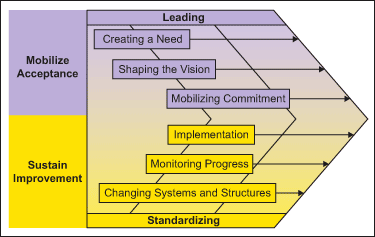
When evolving a culture of continuous process improvement using associated methodologies such as Six Sigma or Lean, the ultimate goal is to improve business performance. An important factor is changing the underlying culture of an organization. It is important to define culture in terms of the organization, and to understand its ramifications to the organization. Culture is how an organization classifies, communicates and acts in a given situation. Therefore, effective cultural change is the result of changed norms and beliefs of individuals reinforced by actions supporting the desired change. Linking continuous process improvement to business performance is one of the greatest challenges faced by the organization. Without this linkage, continuous improvement is scatter-shot at best and random at worst.
Making a connection between continuous process improvement and business results can be problematic. There are many reasons including the defense of the status quo, resistance to innovation or fear of reprisal, but a significant reason is that the language of continuous process improvement is not normally the language of business results. For example, terms like “flow day” or “defect rate” Are often unfamiliar. Even more often, one can hear debates over whether an improvement results in cost savings or cost avoidance. Aligning continuous process improvement with the language and direction of an organization’s business results is crucial in shaping an effective improvement culture.

What Should an Organization Do?
Research suggests that in an organization, the personnel typically fall into a normal distribution of attitudes towards continuous process improvement (Figure 1). There are a small number willing to lead change, the adopters, and a small number that actively fight change, the fighters. The balance – a large majority – is in the middle. Normally organizations focus on rewarding the adopters, and discouraging or ignoring the fighters, but since a large majority of people are neutral, logic would dictate a focus on the center. The objective would be to shift the average attitude toward adopter.
A culture change acceleration model is useful at this point. The model is split into two categories of actions with three activities each and provides a useful outline for creating a management framework which addresses the entire organization. At the executive level of an organization, the focus, and therefore the management structure, should be on:
- Mobilizing acceptance and shifting the neutrals in the direction of the adopters while maintaining the adopter portion of the population.
- Sustaining and standardizing business results across the organization.
The specific activities in each of the focus areas are illustrated in Figure 2.

How Should an Organization Do It?
Knowing what to do, must be followed by knowing how to do it. The basic steps are somewhat different for each organization based on its maturity and capability. As in many business processes, the steps are a continuum with no clear end or beginning. They are based on the PDCA “Deming Cycle” (plan, do, check, act), and the Six Sigma DMAIC roadmap (Define, Measure, Analyze, Improve, Control). The steps are:
1. Organize planning and implementation teams: At each organizational level a team is sponsored by the senior leader, chaired by one of the senior leader’s staff, and consists of the leaders of the subordinate organization. The role of the senior leader is primarily to “mobilize acceptance,” and the chairman’s is to “implement and sustain improvement.” The distribution of these roles is flexible and can be fluid based on the situation. While going through the organization phase, an organization is likely to uncover problems. These are not new problems, but will need to be effectively resolved in order to keep up continuous process improvement momentum. As the teams are cascaded down through the organization, the teams become less “steering teams,” and more tactically focused “implementation teams.”
A. Steering teams sanction the overall program; set vision, mission and overall goals; communicate to all hands; make policy decisions; approve recommendations; create accountability for lower level teams; assure resource availability, and ensure the results from sub-teams are institutionalized across the enterprise where appropriate.
B. Implementation teams implement continuous process improvement and coordinate results with steering teams. Their main role is to train, equip and enable the discrete process teams, Lean event teams, Six Sigma project teams, etc. They also play a key role in implementing the best practices created by other teams where applicable.
2. Align business goals up and down the organization: This is the process of ensuring the organization and its sub-organizations are all moving in the same direction. Most organizations are fairly good at this. Some names for this activity are Hoshin planning, policy deployment, strategic alignment and deployment or balanced score-carding.
3. Identify measurements (create them if needed): Identify or create consistent measures to track aligned business goals and gauge the effectiveness of the continuous process improvement effort. Spend time on this step. Downstream measurement system changes make it difficult or even impossible to do 1-to-1 comparisons over time.
4. Align continuous process improvement activity (but not too tightly): Use the hierarchal teams to drive accountability to organizational goals. For example, most continuous process improvement teams, projects, etc. need to define, in their business cases, how their activities will improve the aligned business goals, and improve the organization’s metrics. Care should be taken in allowing continuous process improvement to take place in problem areas with weaker correlation to business results such as annoyance areas or high interest areas. Create accountability for results: Follow-up should be rigorously implemented at each team level to ensure the continuous process improvement effort is effective, standardized across the enterprise, and have the desired results in terms of the organization’s metrics.
Continuous process improvement and a culture of proactive change adopters will not come overnight. Management cannot communicate or support too much. Diligence and hard work are required at every level. As with almost anything else, proactive leadership, management and accountability for results are the best tools to ensure success.